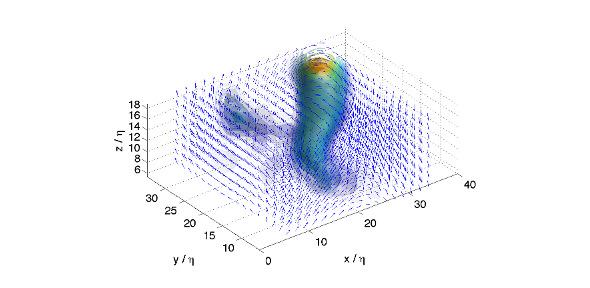
Dr Tim Nickels and Dr James Dawson, collaborating with colleagues at Imperial College London, and the University of Southampton, have been awarded a grant to study the fine-scale structure of turbulence. EPSRC have awarded GBP1.67 million split between the three institutions (GBP740k Cambridge, GBP750k Imperial and GBP180k Southampton). The grant is for fundamental research into the structure of turbulence.
Most flows of practical interest are turbulent and hence the understanding of these flows is important for both engineering and fundamental reasons. Unfortunately, turbulence remains "the most important unsolved problem of classical physics". It consists of a wide range of three-dimensional motions, from large and slow to small and fast. The smallest (and most rapid) motions dissipate the kinetic energy of the flow and determine drag on bodies, dispersion of pollutants and chemical mixing. Unfortunately the very smallness of these motions has, until recently, made them inaccessible to both experiments and computations in flows of practical importance. Predictions of turbulent flows have thus been based on uncertain theories and models of these "fine scales" which are assumed to be the same for all flows i.e. universal. No-one knows if this is true or not. Answering this question requires measurements of a range of flows using techniques capable of resolving their full structure in space as it evolves in time. New techniques developed by the applicants have, for the first time, made the full measurement of these motions possible. Similar advances in computational methods has provided the opportunity for meaningful comparisons with such measurements.
In this collaborative initiative, the team aim to develop and employ a series of advanced laser diagnostic techniques to measure the time-resolved, three-dimensional features of the fine-scales in a series of 'canonical' turbulent shear flows in order to test the hypothesis of universality. Measurements will also be taken at Reynolds numbers accessible to Direct Numerical Simulations especially carried out with this purpose for cross-comparison and validation. The experimental techniques will be based on cinematographic scanning and tomographic Particle Image Velocimetry (PIV) techniques. Regardless of whether the universality hypothesis holds or not, the necessary information to formulate physics based fine-scale models that can account for the multi-scale interactions will be obtained. The data as well as the 3D PIV software will be made available online for researchers in the UK and around the world.
The video at the link below shows the evolution of the fine structures of turbulence in time. Areas colored green/blue show regions where the kinetic energy is dissipated by viscosity and the red/brown areas show regions of high rotation-rate (vorticity). A range of structures may be seen from tube-like worms to sheet like structures. Of particular interest are long trains of vortices nested in regions of high dissipation such as that shown in the still frame that links to the video. This video sequence was produced by Dr Nick Worth as part of his PhD research. The measurements are made using a Tomographic Particle Image Velocimetry system developed in-house.

